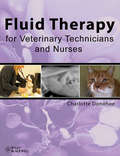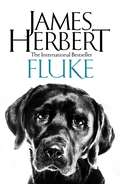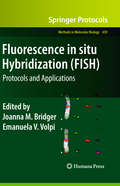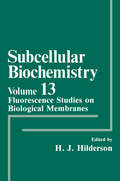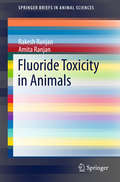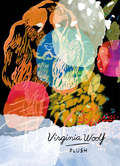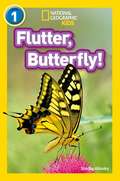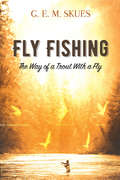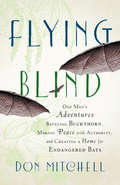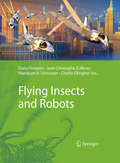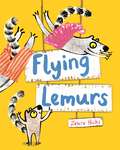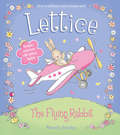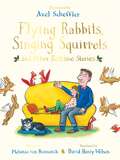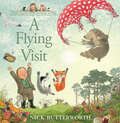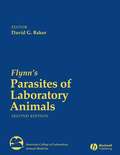- Table View
- List View
Fluid, Electrolyte, and Acid-Base Disorders in Small Animal Practice
by Stephen P. DiBartolaThe leading reference for the diagnosis and management of fluid, electrolyte, and acid-base imbalances in small animals, Fluid, Electrolyte, and Acid-Base Disorders in Small Animal Practice, 4th Edition provides cutting-edge, evidence-based guidelines to enhance your care of dogs and cats. Information is easy to find and easy to use, with comprehensive coverage including fluid and electrolyte physiology and pathophysiology and their clinical applications, as well as the newest advances in fluid therapy and a discussion of a new class of drugs called vaptans. Lead author Stephen DiBartola is a well-known speaker and the "go-to" expert in this field, and his team of contributors represents the most authoritative and respected clinicians and academicians in veterinary medicine. - Over 30 expert contributors represent the "cream of the crop" in small animal medicine, ensuring that this edition provides the most authoritative and evidence-based guidelines. - Scientific, evidence-based insights and advances integrate basic physiological principles into practice, covering patient evaluation, differential diagnosis, normal and abnormal clinical features and laboratory test results, approaches to therapy, technical aspects of therapy, patient monitoring, assessing risk, and prediction of outcomes for each disorder. - Hundreds of tables, algorithms, and schematic drawings demonstrate the best approaches to diagnosis and treatment, highlighting the most important points in an easy-access format. - Drug and dosage recommendations are included with treatment approaches in the Electrolyte Disorders section. - Clear formulas in the Fluid Therapy section make it easier to determine the state of dehydration, fluid choice, and administration rate and volume in both healthy and diseased patients. - Updated chapters cover the latest advances in fluid therapy in patient management, helping you understand and manage a wide range of potentially life-threatening metabolic disturbances. - Expanded Disorders of Sodium and Water chapter includes information on a new class of drugs called vaptans, vasopressin receptor antagonists that may soon improve the ability to manage patients with chronic hyponatremia. - Hundreds of new references cover the most up-to-date advances in fluid therapy, including renal failure and shock syndromes.
Fluid Therapy for Veterinary Technicians and Nurses
by Charlotte DonohoeFluid Therapy for Veterinary Technicians and Nurses provides veterinary support staff with essential information on administering fluid therapy. Encompassing catheter placement, monitoring of intravenous fluid therapy, long-term fluid therapy, intravenous nutrition, equipment, and potential complications, the book supports the reader in obtaining and maintaining intravenous access, monitoring patient responses, and reacting to changes in the patient’s condition. With complete coverage of the principles and procedures, Fluid Therapy for Veterinary Technicians and Nurses offers both a solid grounding in the fundamentals and more advanced information for experienced technician. Designed for ease of use, each chapter begins with the basics, giving a thorough foundation of information, and then moves into more advanced information, with potential nursing concerns and complications highlighted within the text. A companion website offers images from the book in PowerPoint and review questions and answers for download at www.wiley.com/go/donohoenursing. Fluid Therapy for Veterinary Technicians and Nurses is a useful resource for experienced veterinary technicians and vet tech students alike.
Fluid Therapy for Veterinary Technicians and Nurses
by Charlotte DonohoeFluid Therapy for Veterinary Technicians and Nurses provides veterinary support staff with essential information on administering fluid therapy. Encompassing catheter placement, monitoring of intravenous fluid therapy, long-term fluid therapy, intravenous nutrition, equipment, and potential complications, the book supports the reader in obtaining and maintaining intravenous access, monitoring patient responses, and reacting to changes in the patient’s condition. With complete coverage of the principles and procedures, Fluid Therapy for Veterinary Technicians and Nurses offers both a solid grounding in the fundamentals and more advanced information for experienced technician. Designed for ease of use, each chapter begins with the basics, giving a thorough foundation of information, and then moves into more advanced information, with potential nursing concerns and complications highlighted within the text. A companion website offers images from the book in PowerPoint and review questions and answers for download at www.wiley.com/go/donohoenursing. Fluid Therapy for Veterinary Technicians and Nurses is a useful resource for experienced veterinary technicians and vet tech students alike.
Fluke (Plaza Y Janes Exitos Ser.)
by James HerbertFluke is the moving story of a dog with the memories of a human, with the signature twisting plot James Herbert is famed for.A dog wanders the streets, compelled by a ravenous hunger. Hunting a prey he cannot not define, driven by a primal instinct he cannot ignore. He is more than he thinks, more than he can remember and in the depths of his brain the memory of what he once was is clawing for release . . .
Fluorescence in situ Hybridization: Protocols and Applications (Methods in Molecular Biology #659)
by Joanna M. Bridger and Emanuela V. VolpiFluorescence in situ Hybridization (FISH) belongs to that special category of well-established molecular biology techniques that, since their inception a few decades ago, have succeeded in keeping a prominent position within the constantly expanding list of laboratory pro- dures for biomedical research and clinical diagnostics. The design simplicity and cost-effectiveness of the early FISH protocols, combined with the signifcant acceleration of discoveries in related technical areas such as fuor- cence microscopy, digital imaging, and nucleic acid technology have prompted the div- sifcation of the original technique into an outstanding number of imaginative and useful applications, and thus have not only held back its outmoding but have also promoted its expansion into different areas of basic and applied research in the post-genomic era. The 34 chapters included in this book aim at portraying the vibrant complexity and diversity of the current FISH protocol landscape, providing cutting-edge examples of va- ous applications for genetic and developmental research, cancer research, reproductive medicine, diagnostic and prognostic purposes, microbial ecology, and evolutionary st- ies. The book is divided in four parts: (I) Core Techniques, (II) Technical Advancements and Novel Adaptations, (III) Translational FISH: Applications for Human Genetics and Medicine, and (IV) Protocols for Model Organisms.
Fluorescence Microscopy and Fluorescent Probes
by J. SlavíkFluorescence microscopy images can be easily integrated into current video and computer image processing systems. People like visual observation; they like to watch a television or computer screen, and fluorescence techniques are thus becoming more and more popular. Since true in vivo experiments are simple to perform, samples can be directly seen and there is always the possibility of manipulating the samples during the experiments; it is an ideal technique for biology and medicine. Images are obtained by a classical (now called wide-field) fluorescence microscope, a confocal scanning microscope, upright or inverted, with epifluorescence or transmission. Computerized image processing may improve definition, and remove glare and scattered light signal. It also makes it possible to compute ratio images (ratio imaging both in excitation and in emission) or lifetime imaging. Image analysis programs may supply a great deal of additional data of various types, starting with calculations of the number of fluorescent objects, their shapes, brightness, etc. Fluorescence microscopy data may be complemented by classical measurement in the cuvette yr by flow cytometry.
Fluorescence Studies on Biological Membranes (Subcellular Biochemistry #13)
by Herwig J. HildersonAs stated by its first editor, Dr. D. B. Roodyn, the primary goal of the series Subcellular Biochemistry is to achieve an integrated view of the cell by bringing together results from a wide range of different techniques and disciplines. This volume deals with the applications of fluorescence spectroscopy to membrane research. It seeks to present complementary biochemical and bio physical data on both the structure and the dynamics of biological membranes. Biophysics and biochemistry are improving more and more in their ability to study biomembranes, overlapping somewhat in this area and explaining the functioning of the whole cell in terms of the properties of its individual com ponents. Therefore, we have brought together an international group of experts in order to report on and review advances in fluorescence studies on biological membranes, thereby highlighting subcellular aspects. The first chapters present a critical evaluation of the current applications of dynamic and steady-state fluorescence techniques. Subsequent chapters dis cuss more specific applications in cells, biological membranes, and their con stituents (lipids, proteins).
Fluoride Toxicity in Animals (SpringerBriefs in Animal Sciences)
by Rakesh Ranjan Amita RanjanThis book describes in detail various aspects of fluoride toxicity in animals. Animals, like human beings, suffer from the toxic effects of excess fluoride intake. They show pathological changes in their teeth and bone, together with a marked reduction in appetite, productive and reproductive potentials, which can result in severe economic losses in the dairy industry. Laboratory and wild animals also suffer from this ailment. Animal suffering and economic losses alike can be minimized through early diagnosis of the problem and by adopting suitable preventive and therapeutic measures. The book details the susceptibility of different animal species, important sources of toxicity, clinical signs and symptoms, pathophysiology, diagnostic methods, preventive and therapeutic approaches. It offers a valuable resource for scientists working in the fields of toxicology, veterinary science, animal nutrition, and environmental science, as well as for public health workers, animal welfare activists, public health veterinarians, field veterinarians, medical professionals and all others interested in the subject.
Flush: A Biography (Vintage Lives #6)
by Virginia WoolfFlush was an English cocker spaniel who belonged to the nineteenth-century poet Elizabeth Barrett Browning. Virginia Woolf learned of him from the love letters Elizabeth wrote to her future husband, fellow poet Robert Browning, and found ‘the figure of their dog made me laugh so, I couldn't resist making him a Life.’ The resulting ‘biography’ combines sensuous imaginative description with sharp social comment, and brings Woolf’s unsentimental humour and insight to the fore. We see Flush as loyal confidant to Elizabeth on her sickbed at Wimpole Street, and from his jealous perspective we witness her courtship by Browning, their elopement and new life in Italy. The perfect accessible introduction to Woolf’s genius, a unique blend of fact and fiction, Flush is perhaps best read in the company of a canine companion.This edition includes the four original illustrations by Vanessa Bell and an afterword by Margaret Forster.Cover designed by the award-winning Finnish designer Aino-Maija Metsola
Flutter, Butterfly!: Level 1 (National Geographic Readers Ser.)
by Shelby Alinsky National Geographic Kids StaffNational Geographic Primary Readers pair magnificent National Geographic photographs with engaging text by skilled authors to help your child learn to read. Developed by education experts, this series of books for beginner readers is spread across four levels: Early Reader, Becoming Fluent, Becoming Independent and Independent Reader. Flutter, Butterfly! is a colourful book that uses simple vocabulary and fun pictures to capture the interest and help develop the skills of early readers. Told in simple yet lively text, Flutter, Butterfly! will enchant children who are just beginning their reading journey. Level 1: Early Reader books contain simple sentences and are just right for kids who can decode with ease and are beginning to read fluently. They are ideal for readers of Yellow and Blue book bands for guided reading.
Fly-By-Night
by K M PeytonRuth has never ridden a pony before - but as soon as she lays eyes on lively Fly-by-Night, she knows he has to be hers. But where is she going to find the money for a saddle and bridle - and who is going to teach her to ride?
Fly Fishing: The Way of a Trout With a Fly
by G.E.M. SkuesAttorney G. E. M. Skues drew upon his vast experience as a recreational fisherman to write this masterpiece of the fly fishing genre, in which he established sunken flies as essential tools for the well-equipped angler. Originally published in 1921, this seminal book retains its relevance in a world in which the quiet pleasures of river fishing remain unchanged. Professional, competitive, and amateur fishermen as well as beginners will appreciate its timeless wisdom.
Fly Home, Blue!: Independent Reading Orange 6 (PDF) (Reading Champion #3)
by Penny DolanTom has a brilliant racing pigeon called Blue. Grandad has arranged for Blue to fly in his first race! Everyone is very excited, especially Blue, but can he find his way home to Tom and Grandad?Reading Champion offers independent reading books for children to practise and reinforce their developing reading skills.Fantastic, original stories are accompanied by engaging artwork and a reading activity. Each book has been carefully graded so that it can be matched to a child's reading ability, encouraging reading for pleasure.
Fly (Large Print)
This is a picture of a fly viewed from the top and facing towards the top of the page. There is a locator dot shown, which will be at the top left of the page when the image is the right way up. Just down the page, there is a silhouette of the fly at approximately real size. Its head with mouth parts and two enormous eyes is at the top centre of the page. Down the page, the fly's thorax is shown, with two legs and a wing on either side. Further down the page is the abdomen with a leg on either side. Although this cannot be seen, these legs connect to the underside of the thorax. The abdomen is covered in fine hairs.
Fly Me to Moongate Manor: An absolutely heart-warming novel of friendship, romance and second chances, perfect for Spring 2023!
by Kate ForsterA brand new cosy romance by the bestselling author of Starting Over at Acorn Cottage, coming to you April 2023!A surprise raffle ticket.A beautiful manor in the British countryside.Three strangers looking for a place to call home.Amanda's world falls apart when her mother passes away. Stuck with a non-committal boyfriend and a soulless job, she has never felt more alone in New York.Ever since his girlfriend left him broke and heartbroken, Simon has been riding his motorcycle around England all summer looking for a distraction.Diana, the enigmatic lady of Moongate Manor, has not been seen by the locals in decades, fueling the town's gossip on her secret past.When unexpected circumstances bring them all to Moongate Manor with the common mission of restoring its once beautiful garden, can three strangers find new starts in the most unexpected of places?Readers love Fly Me to Moongate Manor!'Would love to be flown to Moongate Manor! Loved, loved, loved this book.' 5 stars, NetGalley Reviewer'What a Magical read this book is, a past secret, a beautiful Manor House and second chances for three people... I loved this book so much... would give it more than five stars if I could.' 5 stars, NetGalley Reviewer'A treat for anyone who enjoyed The Secret Garden There is a definite feel that both the garden and the people are transforming... I loved it!' 5 stars, NetGalley Reviewer'This story still has me thinking about it… weeks later... beautiful... Kate's beautiful way of weaving words has my brain picturing every last detail of the gardens and every character! Another winner from Kate.' 5 stars, NetGalley Reviewer 'A story of friendship, old secrets and forgiveness. A perfect story.' 5 stars, NetGalley Reviewer'Wonderfully entrancing tale of three very different lost souls who coincidentally all end up at the magical moongate manor and in doing so become whole again... A really special read that I would thoroughly recommend to all!' 5 stars, NetGalley Reviewer'Full of twists and turns in a delightful setting. Kate Forster at her best.' 5 stars, NetGalley Reviewer'Loved it. A great read and ace ending.' 5 stars, NetGalley Reviewer
Fly (UEB Contracted)
This is a picture of a fly viewed from the top and facing towards the top of the page. There is a locator dot shown, which will be at the top left of the page when the image is the right way up. Just down the page, there is a silhouette of the fly at approximately real size. Its head with mouth parts and two enormous eyes is at the top centre of the page. Down the page, the fly's thorax is shown, with two legs and a wing on either side. Further down the page is the abdomen with a leg on either side. Although this cannot be seen, these legs connect to the underside of the thorax. The abdomen is covered in fine hairs.
Fly (UEB uncontracted)
This is a picture of a fly viewed from the top and facing towards the top of the page. There is a locator dot shown, which will be at the top left of the page when the image is the right way up. Just down the page, there is a silhouette of the fly at approximately real size. Its head with mouth parts and two enormous eyes is at the top centre of the page. Down the page, the fly's thorax is shown, with two legs and a wing on either side. Further down the page is the abdomen with a leg on either side. Although this cannot be seen, these legs connect to the underside of the thorax. The abdomen is covered in fine hairs.
Flying Blind: One Man's Adventures Battling Buckthorn, Making Peace with Authority, and Creating a Home for Endangered Bats
by Don MitchellWhen Middlebury writing professor Don Mitchell was approached by a biologist with the Vermont Fish and Wildlife Department about tracking endangered Indiana bats on his 150-acre farm in Vermont's picturesque Champlain Valley, Mitchell's relationship with bats—and with government—could be characterized as distrustful, at best. But the flying rats, as Mitchell initially thinks of them, launched him on a series of "improvements" to his land that would provide a more welcoming habitat for the bats—and a modest tax break for himself and his family. Whether persuading his neighbors to join him on a "silent meditation," pulling invasive garlic mustard out of the ground by hand, navigating the tacit ground rules of buying an ATV off Craigslist, or leaving just enough honeysuckle to give government inspectors "something to find," Mitchell’s tale is as profound as it is funny—a journey that changes Mitchell’s relationship with Chiroptera, the land, and, ultimately, his understanding of his own past. Ruminating on the nature of authority, the purview of the state, and the value of inhabiting one’s niche—Mitchell reveals much about our inner and outer landscape, in this perfectly paced and skilled story of place.
Flying fish (UEB contracted)
by RnibFlying fish inscribed: ‘Bolador' and ‘The flyeng fishe'. John White, about 1585. Watercolour and bodycolour over pencil, with silver and gold. Size: 28.5 by 24 cm. Flying fish are found in great numbers off the Outer Banks of North Carolina, where they are caught by dorado and birds. White has mistakenly inscribed the drawing ‘bolador' instead of using the Spanish word for flying, ‘volador'. The lead white he used to indicate the transparency of the wings has altered chemically to grey. The painting shows the flying fish with its "wings" outstretched, its head on the left and its tail on the right. The "wings" of the fish are actually enlarged pectoral fins which are used to "fly". Also shown is the left eye, dorsal fin, two pelvic fins and tail fins. The painting has been labelled, at the top is the word "Bolador" and towards the bottom are the words "The flyeng fishe". The colours used are brown and blue. The tactile image is very similar to the actual painting. Lines and a texture have been used to show some of the detail on the fish. Braille labels have been added for: enlarged pectoral fin, head, eye, pelvic fin, dorsal fin and tail fin. The text on the painting has been given in braille in the same position as the print.
Flying Insects and Robots
by Dario Floreano Jean-Christophe Zufferey Mandyam V. Srinivasan Charlie EllingtonFlying insects are intelligent micromachines capable of exquisite maneuvers in unpredictable environments. Understanding these systems advances our knowledge of flight control, sensor suites, and unsteady aerodynamics, which is of crucial interest to engineers developing intelligent flying robots or micro air vehicles (MAVs). The insights we gain when synthesizing bioinspired systems can in turn benefit the fields of neurophysiology, ethology and zoology by providing real-life tests of the proposed models. This book was written by biologists and engineers leading the research in this crossdisciplinary field. It examines all aspects of the mechanics, technology and intelligence of insects and insectoids. After introductory-level overviews of flight control in insects, dedicated chapters focus on the development of autonomous flying systems using biological principles to sense their surroundings and autonomously navigate. A significant part of the book is dedicated to the mechanics and control of flapping wings both in insects and artificial systems. Finally hybrid locomotion, energy harvesting and manufacturing of small flying robots are covered. A particular feature of the book is the depth on realization topics such as control engineering, electronics, mechanics, optics, robotics and manufacturing. This book will be of interest to academic and industrial researchers engaged with theory and engineering in the domains of aerial robotics, artificial intelligence, and entomology.
Flying Lemurs
by Zehra HicksA funny, reassuring story about overcoming fears and discovering hidden talents.Everyone in the lemur family is good at jumping - even Grandma, whose speciality is being shot from a cannon. Everyone, that is, except the littlest lemur. He just can't do it, no matter how hard he tries. But there are so many jumps to choose from, surely he will manage one, and be able to take his rightful place on stage with the rest of the troupe?Flying Lemurs is a charming, comic story for would-be acrobats everywhere. Colourful, bold, and bursting with energy, this is visual storytelling at its best from the talented author/illustrator Zehra Hicks. You'll be rooting for the little lemur from the start as he gradually overcomes his fears and finds his true calling in style.
The Flying Rabbit (Lettice)
by Mandy StanleyLettice is a little rabbit with big dreams! As Lettice hops around on the hill with her family she sees a little bird flying overhead, swooping and looping and then soaring away.'How wonderful it must be to fly,' Lettice thinks and from that moment she makes up her mind that somehow or other she will…
Flying Rabbits, Singing Squirrels and Other Bedtime Stories
by Melanie von BismarckMolly loves to listen to her dad's bedtime stories. Once upon a time, he says, everyone was green, squirrels sang in choirs, tiny people lived in Aunt Elsie's pot plant and of course, rabbits could fly . . . but can all this really be true? Molly thinks her dad's just being silly as usual, but no-one's bedtime stories are as good as his. So cuddle up on the sofa and pick one of these fourteen fantastically funny stories to read together before bed. Which one will be your favourite?Melanie von Bismarck's brilliant collection of short stories is cleverly translated from the German by David Henry Wilson, author of the Jeremy James series, and is brought to life by the warm, witty and richly detailed pictures by Axel Scheffler, illustrator of The Gruffalo.With a jacket, extra-thick paper, and a special ribbon to mark your place in the book, Flying Rabbits, Singing Squirrels and Other Bedtime Stories makes a great present – truly a gift book to treasure.
A Flying Visit (A Percy the Park Keeper Story)
by Nick ButterworthAn exciting picture book about much-loved Percy the Park Keeper and his animal friends from the bestselling creator of One Snowy Night.
Flynn's Parasites of Laboratory Animals
by David G. BakerPrepared under the auspices of the American College of Laboratory Animal Medicine, this second edition has been thoroughly updated and revised to improve utility and readability. The book is now organized by vertebrate host species, with parasites presented phylogenetically within chapters. Additional highlights of this edition include introductory chapters on modern diagnostic techniques and parasite biology, and a new appendix features a complete drug formulary. The well-presented and extensively illustrated volume addresses all aspects of laboratory animal parasites. Regarded as the most comprehensive and authoritative work available on the topic, this book is an essential reference for veterinary parasitologists, clinicians, students and laboratory animal scientists.

